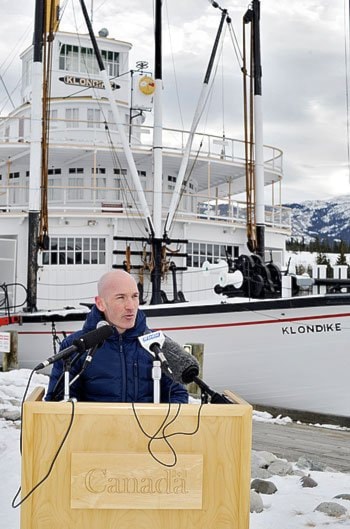It was a busy week in Whitehorse for Yukon MP Ryan Leef.
The territory’s representative in Ottawa held a string of press conferences in the city to announce $7.4 million in funding for two local initiatives.
The federal and territorial governments are teaming up for a $1.3-million study looking at the effects of climate change on melting permafrost in the territory.
Ottawa is splitting the money - $600,000 to study permafrost and its impacts on the Yukon’s roads and highways and $344,000 to help understand hydrological impacts of climate change on the Dempster Highway. The territory will make up the difference.
“These two projects will help us better understand and better plan the construction of future infrastructure projects. It will help us understand the unique challenges that we face in a northern environment,” Leef said, adding that maintaining the Yukon’s transportation infrastructure as the permafrost under it melts is an important step to bolstering the territory’s economy.
“Permafrost underlies more than 50 per cent of the Yukon’s terrain,” said Yukon Environment Minister Currie Dixon.
“When something affects permafrost, it also includes what’s built above it. In recent years we have witnessed some dramatic effects of melting permafrost along our highways and at our airports,” Dixon said.
The territory will work with a number of partners including the federal government, Laval University, University of Montreal, University of Alaska, the U.S. Federal Highways Administration and Yukon College’s Cold Climate Innovation Centre.
The research will examine the permafrost at a number of highway sites around the Yukon, and monitor changes over time.
The goal is to gather enough data to help Highways and Public Works build roads and buildings that are more resistant to permafrost melting as the planet warms.
Dixon said some construction in the territory is already being informed by work on permafrost happening at the college’s Cold Climate Innovation Centre.
“The best example I can give is in Mayo, where folks from the research centre have identified sites that are likely to be affected by melting permafrost, and have then used that to help make decisions about where they build and how they build,” Dixon said.
Last week in Ottawa, Leef took a shot at both opposition parties for what he called a “coalition on a carbon tax.”
“Our government is putting job creation and economic growth first, while the Liberals have now decided to join the NDP in its carbon tax plan. Their new alliance opposes energy infrastructure before it has undergone independent scientific review,” he said.
On Wednesday he said the federal government takes reducing climate change seriously as well, and pointed to the $500,000 contribution from earlier this year to a feasibility study of biomass energy generation in Haines Junction as an example of government initiatives to reduce Canada’s greenhouse gas emissions.
“We’re always looking at alternative energy solutions. We’re dealing in funding with community-based solutions to community-based challenges.
The government is also looking at sector-by-sector efficiency reviews to find ways of reducing our greenhouse gas outputs, Leef said.
“We know that the transportation industry is one of the biggest emitters of GHG emissions. We’re putting in regulations to make that a cleaner and more effective industry,” Leef said.
Asked if there was a contradiction between carbon-heavy resource extraction in a place like Eagle Plain while also studying the affects of melting permafrost in the very same area, Leef maintained we can deal with both issues simultaneously.
“It’s about finding balance. To say that one has to come at the jeopardy of the other is not the case. Our country is rich in resources, and we need to find a way to access that. Wealth below the ground doesn’t necessarily equate to wealth above the ground.
“What we need to do as a government at multiple levels is find a way to access those resources in a responsible way,” Leef said.
The permafrost press conference was Leef’s second of the day. He held one earlier Wednesday morning to announce $6.4 million in upgrades to the Whitehorse airport.
“It’s essentially to improve the safety for the airplanes docking and to maintain the high quality of runway services at the airport,” Leef said.
The money will go to replacing the airport’s runway apron panels, making it safer for planes docking at the airport, and will help preserve the airport’s international status.
“Maintaining the international designation for us is crucial, and these kinds of continued investments are really important, especially for tourism in the Yukon,” Leef said.
Much of the work will go to local contractors, he said, a significant boon in what has so far been a slow construction year.
Contact Jesse Winter at
jessew@yukon-news.com
